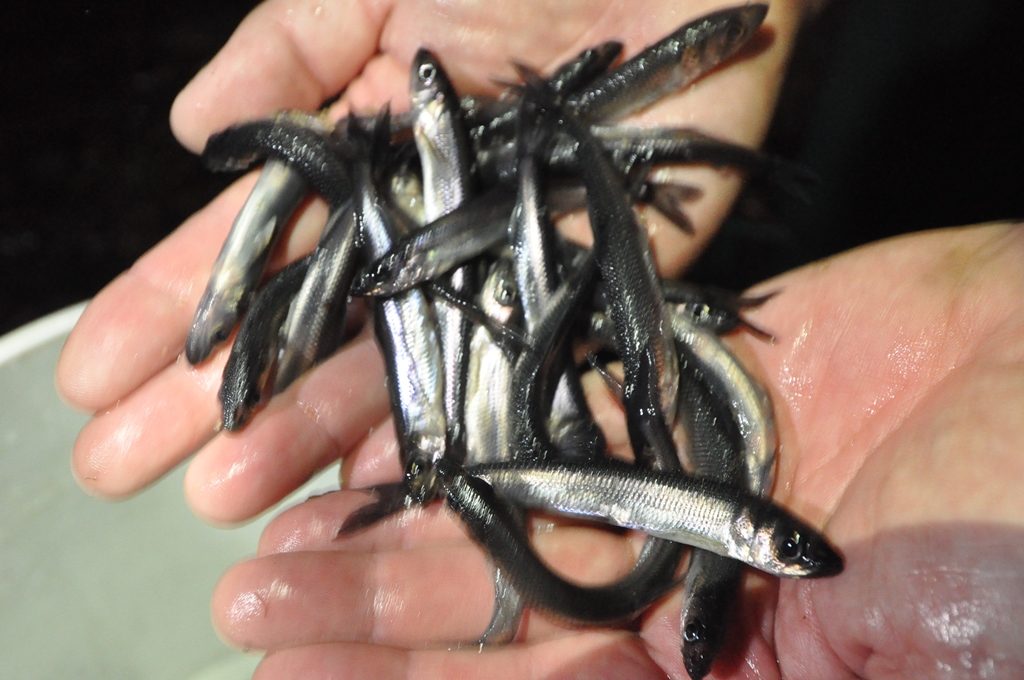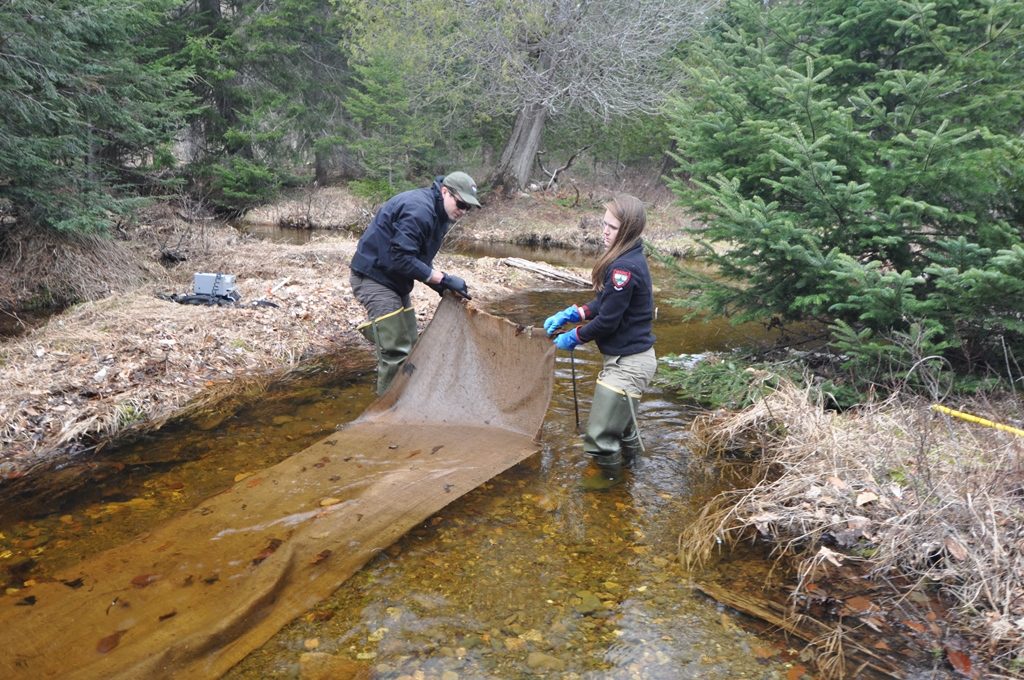June 2, 2017 at 11:14 am
 By IFW Fisheries Biologist Kevin Dunham
A sure sign of spring in Maine is that smelts are running. Rainbow smelt (Osmerus mordax), an important forage fish that’s highly sought after both commercially and recreationally, are found in both fresh and salt water, and can be found running in many Maine streams and brooks every spring.
The rainbow smelt is a small, slender fish with a large mouth and prominent teeth. The smelt is unique in that it plays many roles in Maine; as a sport fish (both lakes and streams); as a key forage fish for larger sport fish species; as a bait fish, and as a source of income for commercial bait dealers.
Unlike anadromous populations (“sea smelts”) which spend the majority of their life in the ocean and ascend freshwater streams during the spring to spawn, landlocked smelt populations spend their entire life in freshwater. There are numerous “freshwater” populations of rainbow smelt throughout the state of Maine. Many species, including landlocked salmon, lake trout and brown trout rely on smelt as a food item and without an abundant smelt population, the size and quality of these fish decline. It is well documented that the overall health and quality of Maine’s landlocked salmon fisheries are largely dependent on smelt population abundance.
Rainbow smelt generally spawn at one to two years of age. Landlocked smelt spawn at night in tributaries of lakes, or even in shallow areas of lakes or offshore shoals. Spawning begins as early as February-March in southern Maine and as late as May-June in northern Maine.
Spawning is typically initiated shortly after ice-out when water temperatures rise above 40o F though most spawning activity occurs at water temperatures around 50o F. Spawning lasts several nights and is often confined to the lowest, slow-moving, stretches of tributaries because smelt are not strong swimmers and they are unable to negotiate swift or turbulent water.
Females sized 7–9 inches in length can release from 21,000 – 41,000 eggs each. Eggs are negatively buoyant and adhesive, attaching to substrate such as gravel, sand, and submerged vegetation. Hatching generally occurs in 2 to 3 weeks depending upon water temperature. After hatching, the transparent larvae, approximately a quarter of an inch in length, drift downstream into the lake. Initially, smelt movement is largely restricted to drifting with existing currents. Young fry are about ¼ inch in length, but grow rapidly and may be 1–1 ½ inches long within a few months.
https://youtu.be/kX-BTJ2xDBs
The use of smelt as forage for gamefish, particularly landlocked salmon, is the Department’s highest management priority for this fish species. Consequently, fisheries managers must work to balance other use opportunities for smelt.
In recent years some waters have been closed to smelt harvest by fishery managers to protect this valuable forage fish in important salmonid waters. Additionally, a number of streams and waters have been closed to smelt dipping due to public concern about overfishing, vandalism, trespass, and littering. Attempts have also been made in recent years to establish smelt populations in additional waters for the purpose of providing sport and bait harvest opportunities.
[caption id="attachment_2377" align="alignright" width="496"]
By IFW Fisheries Biologist Kevin Dunham
A sure sign of spring in Maine is that smelts are running. Rainbow smelt (Osmerus mordax), an important forage fish that’s highly sought after both commercially and recreationally, are found in both fresh and salt water, and can be found running in many Maine streams and brooks every spring.
The rainbow smelt is a small, slender fish with a large mouth and prominent teeth. The smelt is unique in that it plays many roles in Maine; as a sport fish (both lakes and streams); as a key forage fish for larger sport fish species; as a bait fish, and as a source of income for commercial bait dealers.
Unlike anadromous populations (“sea smelts”) which spend the majority of their life in the ocean and ascend freshwater streams during the spring to spawn, landlocked smelt populations spend their entire life in freshwater. There are numerous “freshwater” populations of rainbow smelt throughout the state of Maine. Many species, including landlocked salmon, lake trout and brown trout rely on smelt as a food item and without an abundant smelt population, the size and quality of these fish decline. It is well documented that the overall health and quality of Maine’s landlocked salmon fisheries are largely dependent on smelt population abundance.
Rainbow smelt generally spawn at one to two years of age. Landlocked smelt spawn at night in tributaries of lakes, or even in shallow areas of lakes or offshore shoals. Spawning begins as early as February-March in southern Maine and as late as May-June in northern Maine.
Spawning is typically initiated shortly after ice-out when water temperatures rise above 40o F though most spawning activity occurs at water temperatures around 50o F. Spawning lasts several nights and is often confined to the lowest, slow-moving, stretches of tributaries because smelt are not strong swimmers and they are unable to negotiate swift or turbulent water.
Females sized 7–9 inches in length can release from 21,000 – 41,000 eggs each. Eggs are negatively buoyant and adhesive, attaching to substrate such as gravel, sand, and submerged vegetation. Hatching generally occurs in 2 to 3 weeks depending upon water temperature. After hatching, the transparent larvae, approximately a quarter of an inch in length, drift downstream into the lake. Initially, smelt movement is largely restricted to drifting with existing currents. Young fry are about ¼ inch in length, but grow rapidly and may be 1–1 ½ inches long within a few months.
https://youtu.be/kX-BTJ2xDBs
The use of smelt as forage for gamefish, particularly landlocked salmon, is the Department’s highest management priority for this fish species. Consequently, fisheries managers must work to balance other use opportunities for smelt.
In recent years some waters have been closed to smelt harvest by fishery managers to protect this valuable forage fish in important salmonid waters. Additionally, a number of streams and waters have been closed to smelt dipping due to public concern about overfishing, vandalism, trespass, and littering. Attempts have also been made in recent years to establish smelt populations in additional waters for the purpose of providing sport and bait harvest opportunities.
[caption id="attachment_2377" align="alignright" width="496"] In order to transfer smelt eggs, burlap is laid down in streambeds where there are strong smelt runs. The smelts will deposit eggs on the burlap, and the burlap can then be transferred to another water to augment a smelt population.[/caption]
Fishery biologists commonly use smelt egg transfers to augment existing smelt populations. Smelt stocking is currently conducted via egg transfers from donor waters, because propagation of smelt under hatchery conditions has been marginally successful and there are concerns of transferring parasites and diseases. The Department has a long history of transferring smelt eggs to create or enhance the smelt population, and more recently to establish new smelt populations for the purpose of developing sport and commercial opportunities.
One challenge facing smelt statewide is that habitat is disappearing. As lakes and ponds become more developed, environmental impacts to smelt spawning streams become greater. Increased development of shoreline properties has led to diminishing water quality in some lakes which has resulted in oxygen depletion and loss of smelt habitat. Development and forestry practices can also increase silt run-off which can smother suitable spawning habitat. Invasive species can also have a negative impact on smelt populations as they often compete for the same forage and space.
Smelts are an invaluable species to anglers, bait dealers, game fish, and others, and the Department manages this species to balance these competing needs so that come spring time, smelts will be running upriver in a waterway near you.
In order to transfer smelt eggs, burlap is laid down in streambeds where there are strong smelt runs. The smelts will deposit eggs on the burlap, and the burlap can then be transferred to another water to augment a smelt population.[/caption]
Fishery biologists commonly use smelt egg transfers to augment existing smelt populations. Smelt stocking is currently conducted via egg transfers from donor waters, because propagation of smelt under hatchery conditions has been marginally successful and there are concerns of transferring parasites and diseases. The Department has a long history of transferring smelt eggs to create or enhance the smelt population, and more recently to establish new smelt populations for the purpose of developing sport and commercial opportunities.
One challenge facing smelt statewide is that habitat is disappearing. As lakes and ponds become more developed, environmental impacts to smelt spawning streams become greater. Increased development of shoreline properties has led to diminishing water quality in some lakes which has resulted in oxygen depletion and loss of smelt habitat. Development and forestry practices can also increase silt run-off which can smother suitable spawning habitat. Invasive species can also have a negative impact on smelt populations as they often compete for the same forage and space.
Smelts are an invaluable species to anglers, bait dealers, game fish, and others, and the Department manages this species to balance these competing needs so that come spring time, smelts will be running upriver in a waterway near you.Categories